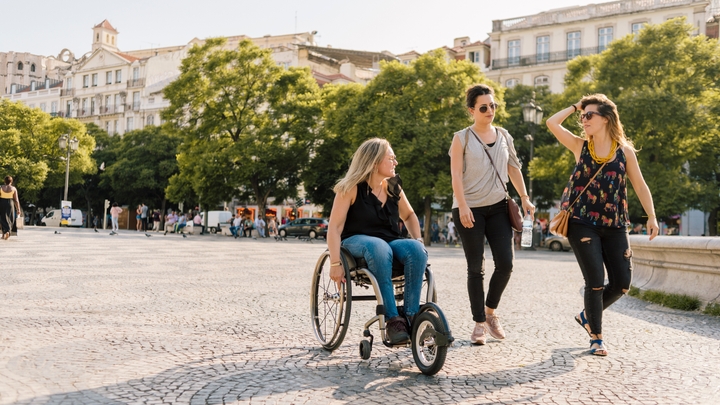Faka izinto ezinceda ilungele wonke umntu kwinto enokonwatyelwa okanye kwinkonzo
Iindwendwe zifuna ukwazi ukuba into enokonwatyelwa okanye inkonzo iyazifikelela na izinto ezizifunayo ngaphambi kokuba zibhukishe. Zingahluza iziphumo zokukhangela zika-Airbnb ukuze zifumane izinto ezithile ezinceda ilungele wonke umntu zize zithumelele ababuki zindwendwe imiyalezo ukuze zicele iinkcukacha ezingakumbi.
Chazela iindwendwe ukuba yintoni ekhoyo ebudeni bento yakho enokonwatyelwa okanye benkonzo ngokukhetha kwizinto ezinceda ilungele wonke umntu kwithebhu Yezinto Ezinokubhukishwa. Ababuki zindwendwe benkonzo banokukhetha intetho yezandla kuphela okwangoku. Ukuba uyakwazi ukwenza nezinye izinto ezinceda abantu, cinga ngokuzichaza ezo nkcukacha kwinto yakho enokubhukishwa okanye kumyalezo wokwamkela.
Ukunceda ngezinto ezivakalayo nezibonakalayo
Zifake ezi zinto ukuba ungakwazi ukunikezela ngentetho yezandla okanye ngomntu obonayo okhokela abantu abangaboniyo.
- Intetho yezandla: Wena, umntu obuka iindwendwe oncedisayo, okanye umntu okuncedisayo unokuqhakamshelana neendwendwe ezingevayo okanye ezingeva kakuhle, okanye alungiselele umntu otolikayo. Zilwimi zezandla ezingaphezu kwe-300 ezisetyenziswa emhlabeni wonke, kuquka isiMerika, isiTshayina nesiSpanish. Cacisa ukuba zeziphi iilwimi zezandla ezifumanekayo.
- Umntu obonayo okhokela abantu abangaboniyo: Ungakwazi ukwenza kubekho umntu okhokela abantu abangaboniyo onamava ukuze ancede iindwendwe ezingaboniyo okanye ezingaboni kakuhle.
Izinto ezinceda ilungele wonke umntu zokuhamba
Zifake ezi zinto ukuba iindwendwe, kuquka abantu abasebenzisa isitulo esinamavili, zinokukwazi ukuhamba kwinto enokonwatyelwa ukususela ekuqaleni ukuya kutsho ekugqibeleni ngaphandle kokudibana nezitepsi okanye nezinye izinto eziyimiqobo.
- Indawo yokungena engenazitepsi: Akukho zitepsi, iindawo eziphakamileyo, okanye izinto eziyimiqobo ezingaphezulu kweeintshi eziyi-2 (iisentimitha eziyi-5) ebudeni bento enokonwatyelwa.
- Igumbi langasese elingenazitepsi: Kukho igumbi langasese iindwendwe ezinokulisebenzisa elingenazitepsi emnyango.
- Ubukhulu becala umhlaba uflethi okanye uthe tyaba: Umhlaba kuyo yonke into yakho enokonwatyelwa ubanzi, uqinile, kwaye zimbalwa okanye azikho indawo eziphakamileyo.
- Indawo yokupaka yabantu abaneziphene: Kukho indawo yokupaka yeendwendwe ezineziphene, okanye indawo ebanzi ngaphezu kwe-8 feet (iimitha eziyi-2,5), kufutshane nendawo eqala kuyo into yakho enokonwatyelwa.
- Iindawo zokungena ezibanzi kuneeintshi eziyi-32: Iindawo zokungena neminyango ekungenwa kuyo kwinto enokonwatyelwa ibanzi ubuncinane ngeeintshi eziyi-32 (iisentimitha eziyi-81).
Ukuba into enokonwatyelwa ayinazo ezi zinto, cinga ngokuba ungayitshintsha na indlela okanye indawo ekuyo ukuze wamkele iindwendwe ezingakumbi ezifuna izinto ezinceda ilungele wonke umntu.
Ukucingela izivamvo
Zifake ezi zinto ukuba into yakho enokonwatyelwa iyakwazi ukwamkela iindwendwe ezikhathazwa zizinto zendalo ezisingqongileyo.
- Azikho izinto ezikhathaza izimvamvo ngokugqithe emngceni: Izinto ozenzayo azinazibane ezininzi ezigqamileyo, izandi ezingxolayo, amavumba abukhali, okanye abantu abaninzi.
- Indawo ezolileyo ekhoyo: Kukho indawo eyahlukileyo engenangxolo ininzi, okanye indawo yakho wedwa, iindwendwe ezinokuyisebenzisa ebudeni bento enokonwatyelwa.
Ukuba ungakwazi ukutshintsha izinto ezithile, cinga ngokwenza into enokonwatyelwa engenazinto zininzi ezikhathaza izimvamvo.
Ukunikezela ngezinto ezinokonwatyelwa neenkonzo ezinezinto ezinceda ilungele wonke umntu kwenza iindwendwe ezingakumbi zibe nethuba lokubhukisha zize zibhukishe zizithembile.
Inkcazelo ekweli nqaku isenokuba itshintshile emva kokuba lipapashiwe.
